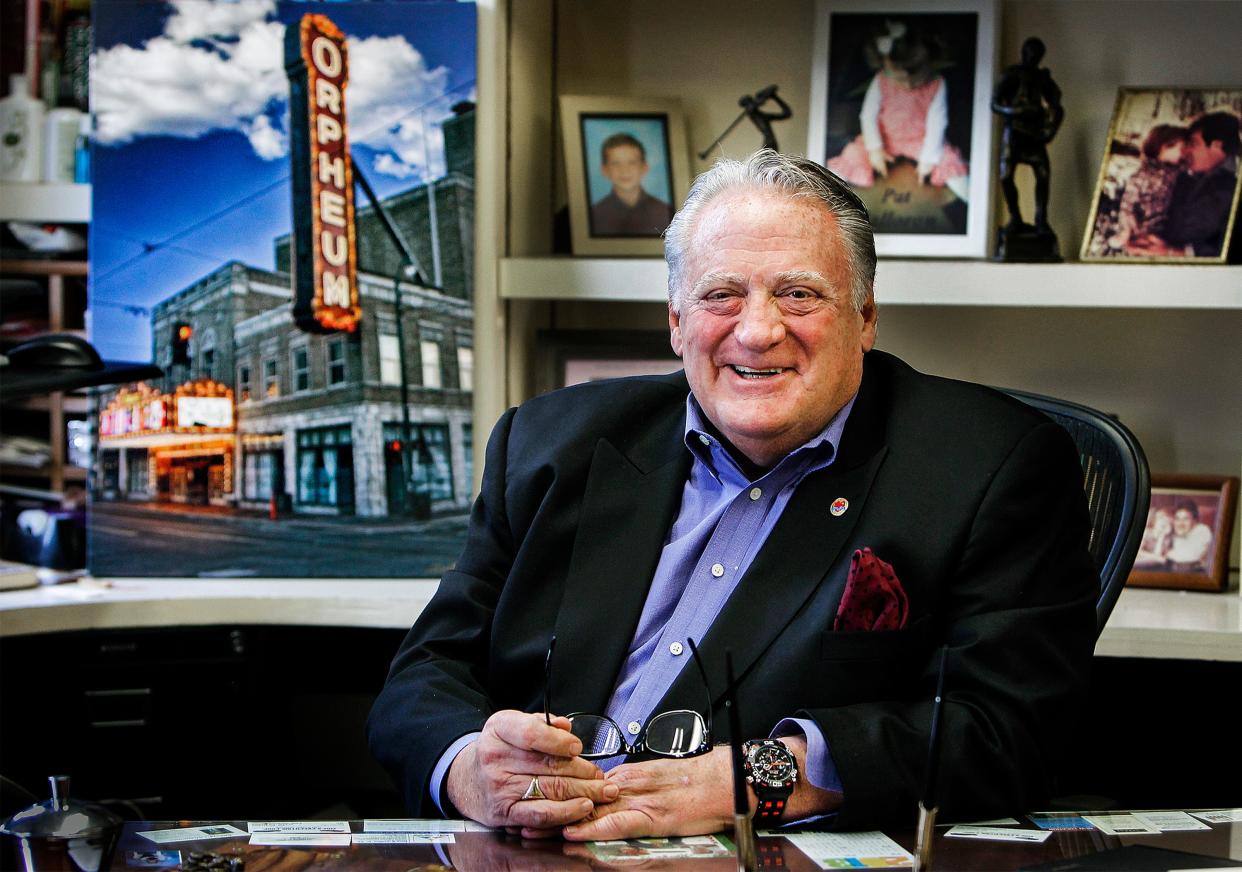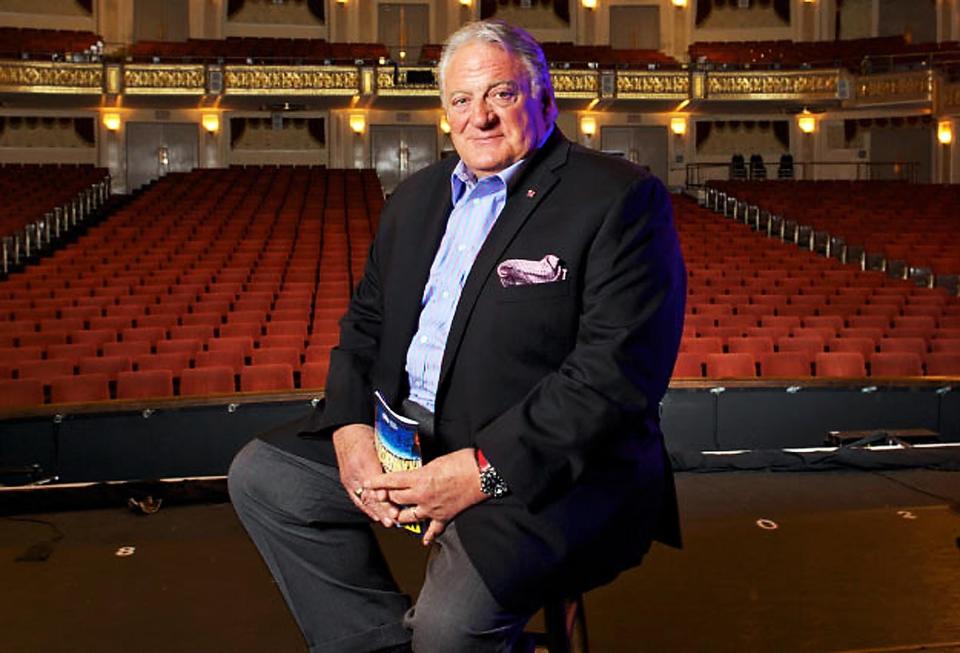Pat Halloran, savior of the Orpheum, has died: 'His legacy is profound'

Pat Halloran, the visionary organizer, fundraiser and arts advocate who headed the campaign to resurrect and restore the Orpheum and remained head of the historic Downtown theater for 35 years, died Thursday at the age of 80.
A burly presence in a restored architectural gem noted for the delicacy of its gold leaf highlights and the elegance of its crystal chandeliers, Halloran's efforts transformed the former movie palace from a symbol of neglect into a beacon of hope and, finally, the cornerstone of a revived and vital Downtown.
"There would be no Orpheum without Pat Halloran," said Brett Batterson, who succeeded Halloran as Orpheum president and CEO in 2016. "His legacy is profound."
Halloran's arts activism extended beyond Memphis. He was a founder of the Independent Presenters Network, a national consortium of theaters and performing arts centers that invests in Broadway productions and helps influence which shows make it to stage and which shows go on tour.
As an IPN co-producer representing the Orpheum, Halloran earned Tony Awards for the Broadway musicals "Thoroughly Modern Millie" (2002) and "Spamalot" (2005). He also earned a Tony as an individual co-producer for "Memphis" (2010), a Sun Records-inspired musical with a multitude of Memphis investors, thanks to Halloran's example.
More important than the awards for theater-loving Memphians, the IPN connection puts the Orpheum near the head of the line when Broadway shows go on the road, which is one reason the Memphis theater continues to be able to schedule such hit shows as "Hamilton," "Wicked" and "The Lion King" with regularity.
"The decades of Broadway tours he brought to Memphis have shaped the memories of hundreds of thousands of theatergoers," Batterson said. He added that through Halloran's "passion and steadfast preservation of the historic 95-year-old theater, Downtown Memphis and live performance continue to thrive."
One of Halloran's later achievements was to lead the development and construction of the Halloran Centre for Performing Arts & Education, which opened in 2015 as a modernist complement to its historic next-door neighbor. Built directly to the south of the Orpheum in the 200 block of Main Street, the Centre contains classrooms, meeting rooms and a theater. Batterson called the Halloran Centre "a haven for transformational arts education" through which Pat Halloran "continues to shape future generations of empathic, thoughtful community members."
“I didn’t see this as being my end — my life’s work,” Halloran told The Commercial Appeal in 2014, reminiscing about his early years with the Orpheum. “But as it turned out, I fell in love with what was going on here.”
Built at Main and Beale on a corner formerly occupied by the city's Grand Opera house, which was destroyed in a fire, the million-dollar Orpheum opened in 1928, with vaudeville performances and “photoplay” screenings.
In 1940, the theater was renamed The Malco, and served as the flagship theater of the Malco Theatres chain. By the 1970s, however, as Downtown deteriorated in the wake of suburban expansion and the assassination of Dr. Martin Luther King Jr., the city's movie palace had become an opulent "grindhouse," devoted to R-rated exploitation films. It closed in 1975.
The Orpheum's resurrection more or less began in 1980, when Halloran — then a former City Council member, failed mayoral candidate and executive with Memphis-based Pi Kappa Alpha, a fraternity with more than 320,000 members in the U.S. and Canada — was hired by the nonprofit Memphis Development Foundation to lead the effort to raise the $5.2 million needed to restore the theater.
A Nebraska native with an entertainment heritage (his father had been a regional vice president for Walt Disney Pictures), Patrick Wilson Halloran III first came to Memphis in 1969, lured here from Miami by the Pi Kappa Alpha job.
“To be honest, I thought, you know, I’m not ever going to be anything big in Miami, that city was rolling," Halloran told The Commercial Appeal. "I saw Memphis as just the opposite. I saw Memphis as a city that had its arms wide open.”
Remembering his first impression of the Orpheum in a column in Downtowner magazine, Halloran wrote: "I mean, this place was in horrible condition."
The restoration, he said, "meant gutting the building; taking the salvageable components such as seats and chandeliers to be cleaned or repaired; replacing what couldn't be salvaged; removing all the grit and grime; and then building it back up."

The job took about four years: The Orpheum reopened in 1984.
Through the decades that followed, Halloran became synonymous with the theater, organizing the movie revivals, Broadway tours, concerts and other events that remain the Orpheum's focus. A gregarious figure with a theatrical streak of his own, he kept the theater at the forefront of the Downtown revival, as the resurrection of Beale Street, the construction of FedExForum, the remodeling of Tom Lee Park and other projects followed.
Halloran chronicled the historic theater's journey in his book, "Orpheum: Where Broadway Meets Beale." But according to Pi Kappa Alpha (commonly known as PIKE), Halloran was the savior of more than the Orpheum.
During his 1969-1980 tenure as the eighth executive director of the group (founded at the University of Virginia in 1868), "he led the Fraternity during some very challenging times and is credited with rescuing ΠΚΑ from the brink of extinction and turning it into one of North America’s leading fraternal organizations," Pi Kappa Alpha reported Friday on its website.
"Pat was one of the most charismatic figures in Pi Kappa Alpha’s history," said Justin Buck, PIKE executive vice president. "He possessed an incredible ability to walk into a room, and despite his larger-than-life persona, make you feel like the most important person there. He impacted the lives of thousands and inspired them to become better men.”
Outside PIKE and the Orpheum, Halloran was especially proud of his work with Big Brothers Big Sisters of the Mid-South, starting in 1972. In addition, he was past chair of the Memphis Convention & Visitors Bureau (now known as Memphis Tourism) and a past board member of the Memphis in May International Festival and the Memphis & Shelby County Music Foundation. He also was on the University of Tennessee Health Science Center College of Medicine Advisory Board.
In 2011, Tennessee Gov. Bill Haslam awarded Halloran the “Governor’s Arts Leadership Award," while Memphis Tourism gave him its “Legends Award” for 2012. Also in 2012, the Public Relations Society of America named him “Communicator of the Year.”
Halloran leaves his wife, Anne Halloran; four children; and six grandchildren.
Funeral arrangements are pending.
This article originally appeared on Memphis Commercial Appeal: Pat Halloran, savior of the Orpheum in Memphis, has died

